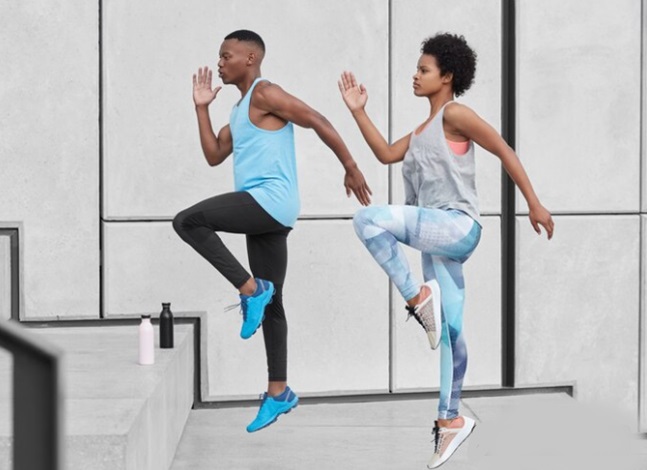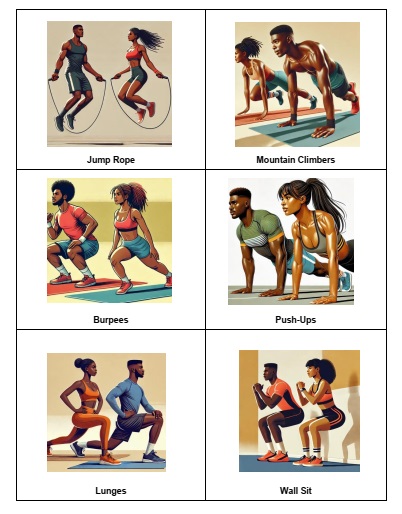High-Intensity Interval Training: A Better Fitness Approach for Africans
By Foluke Akinwalere, Freelance Health writer. Reviewed by: Oluwasola Samuel.

Image of an African young man and woman doing high knee exercise. Image source: Freepik
Exercise plays a crucial role in maintaining a healthy lifestyle, yet many Africans struggle to find a workout routine that fits their busy schedules. High-Intensity Interval Training (HIIT) has emerged as one of the most effective ways to stay fit, lose weight, and improve heart health—all within a short amount of time.
But what exactly is HIIT? Is it suitable for Africans, considering climate, lifestyle, and common health conditions?
This article breaks down what Africans need to know about HIIT exercises, their benefits, and how to safely incorporate HIIT into their daily routines. Whether you are a beginner or an experienced fitness enthusiast, this article will help you understand how HIIT can transform your health.
High-Intensity Interval Training (HIIT) is a type of exercise that involves short bursts of intense exercise at maximum or near-maximum effort, followed by rest or low-intensity movement. Unlike regular exercises that last 45 minutes to an hour; high intensity interval training session may be as short as 10 to 30 minutes while delivering even better results. This is because they rely on short, intense bursts of energy. The length of each interval depends on your fitness level. [1]
A HIIT session has four main parts:
How Does HIIT Work?
During HIIT, you push your body to its maximum effort for a short time—usually 20 to 45 seconds—followed by a rest period or low-intensity movement. For example, as a beginner, you might do 30 seconds of jumping jacks at full speed, then rest for 15 seconds before moving to the next exercise.
Originally, HIIT followed a 20-second workout with a 10-second rest, but now intervals typically range from 20 to 45 seconds. They usually don’t go beyond 75 seconds to keep the focus on high-intensity effort rather than endurance. [1]
HIIT burns more calories in a shorter amount of time because it makes your body work at its peak using fast energy bursts, and this keeps your heart rate elevated. Even after you finish your exercise, your body continues burning fat due to the “afterburn effect” (excess post-exercise oxygen consumption), or EPOC). [2]
.
Many people are looking for ways to stay active, improve their health, and manage their weight. However, long working hours, economic challenges, and limited access to gyms or exercise facilities can make it difficult to maintain a regular fitness routine. HIIT is quickly gaining traction because it offers a solution that is time-efficient, cost-effective, and adaptive to various lifestyles.
Here’s a closer look at why HIIT is becoming one of the most popular workout methods in Africa:
Many Africans juggle multiple responsibilities—work, family, school, and other commitments. These factors make it difficult to spend long hours in a gym or commit to a structured fitness program. HIIT exercises, however, can be adopted and completed in just 10 to 30 minutes, making HIIT perfect for people with busy schedules.
Many HIIT exercises can be done using just your body weight without any fancy machines or expensive equipment—exercises such as push-ups, squats, jumping jacks, burpees, and lunges. This means you can work out in your home, backyard, or even in an open field without needing to spend money on gym fees. Also, free online resources and mobile apps provide workout ideas, making it easy to get started.
Social media has played a huge role in making HIIT popular across Africa. Many fitness enthusiasts, personal trainers, and health experts have embraced platforms like Instagram, YouTube, TikTok, and Facebook to promote simple, high-energy workout routines. Some have even incorporated African dance and cultural movement into HIIT, making it more relatable, fun, and encouraging for Africans.
In recent years, awareness of health issues like heart diseases, diabetes, and high blood pressure has grown in Africa. Governments and health advocates are promoting healthier lifestyles, including regular physical activity. HIIT has become popular due to its effectiveness in improving heart health, lowering blood sugar levels, and boosting endurance.
Africa’s warm climate and strong outdoor exercise culture make HIIT an excellent exercise choice. Many people prefer outdoor workouts, especially in open spaces, parks, or community fields. The flexibility of HIIT means that people can take advantage of the great weather and outdoor settings without feeling confined to indoor exercise spaces.
Many Africans love group activities and find motivation in community-based fitness programs. HIIT workouts can be done in pairs, small groups, or even large community fitness events, making them more engaging and socially rewarding.
Unlike regular exercises that can feel repetitive or boring, HIIT keeps exercise exciting and engaging. It includes a variety of movements, challenges, and fast-paced exercises that prevent boredom and keep workouts enjoyable, such as incorporating African dance moves, Afrobeats-inspired workouts, or skipping rope challenges to make exercise feel less like a chore and more like a fun activity.
What Are the Benefits of HIIT?
Fig. 1: Health benefits of HIIT. Image source: National Library of Medicine. Click on image to enlarge.
1. Improves heart health
Cardiovascular diseases, including hypertension and heart disease, are leading health concerns in Africa. HIIT exercises improve heart function and reduce blood pressure, and enhance circulation, making them excellent for those looking to maintain heart health. [3]
For those looking to shed extra weight, HIIT for weight loss in Africa is a game changer. Studies show that HIIT burns more fat than traditional cardio and increases post-workout calorie burn. [4] The “afterburn effect” of HIIT exercises keeps your metabolism elevated for hours, ensuring that calories continue to burn even after you have finished exercising.
Regular HIIT exercises help regulate sleep patterns, making it easier to fall asleep and enjoy deep, restorative sleep. [5] Better sleep contributes to overall mental and physical health, which reduces the risk of chronic illnesses.
Exercise, especially HIIT, is a powerful stress reliever. It releases endorphins, the body’s natural mood enhancers, helping to reduce anxiety and depression. Africans facing work-related stress or daily challenges can benefit greatly from incorporating HIIT exercises into their routines.
HIIT is not just good for your body—it also has powerful benefits for your mind. HIIT improves focus and memory by increasing the blood flow to the brain, which results in boosting cognitive function. Also, the intensity of HIIT teaches you to push through discomfort, which can improve mental toughness in daily life.
As we age, bone density naturally decreases, which increases the risk of osteoporosis and fractures. HIIT can help keep bones strong and joints healthy. Many HIIT moves engage your core muscles which improve posture and stability.
Ageing gracefully is a priority for many, and the best exercise for healthy ageing can help reduce the undesirable effects that come with ageing. The increased blood circulation from HIIT exercises delivers more oxygen and nutrients to the skin, promoting a youthful glow. Additionally, HIIT reduces inflammation, which is associated with premature ageing.
Watch the video below to learn more about warm-up, high-intensity, and cool-down HIIT exercises you can try:
Click to watch: 20 Minute Full Body Cardio HIIT Workout [NO REPEAT]
Click ion mage to enlarge
No-Equipment HIIT Exercises You Can Use Your Body-weight to Do
Some exercises you can use your bodyweight to do without equipment, as shown in Fig 2.

Fig 2: Some No-Equipment HIIT Exercises. Click on image to enlarge.
Despite the effectiveness and efficiency of HIIT, several myths and misconceptions prevent people from fully embracing it.
Fact: HIIT is for everyone—it is about finding the right intensity and modifications that suit your fitness level. HIIT can be adapted to suit beginners, older adults, and people with mobility issues.
Fact: The truth is that short, well-structured HIIT sessions are more effective than long, exhausting workouts. Stick to short, focused HIIT sessions (typically 20–30 minutes) for maximum benefits.
Fact: HIIT provides multiple health benefits beyond just burning fat. It is a full-body fitness solution that improves overall health.
Fact: Many HIIT exercises require no equipment—just your body weight. Bodyweight exercise such as squats, push-ups, jump lunges, and burpees. You can do them anywhere—at home, outdoors, or in a gym—without fancy equipment.
Fact: HIIT is safe when done with proper form, warm-ups, and rest periods. Listen to your body, progress gradually, and focus on technique.
Fact: Females are strong enough to enjoy sporting activities or physical exercise of their choice. They only require proper training and adequate warm-ups before engaging in these activities. [6]
One of the best things about HIIT is its flexibility—it does not require a gym, expensive equipment, or a lot of time. Whether you are living in a bustling city or in a rural village with limited access to fitness centres, HIIT can easily fit into your lifestyle and daily routine.
Many Africans have hectic schedules, balancing work, family, and other responsibilities.
Africa is rich with landscapes that provide plenty of natural spaces. These free spaces can be used for HIIT workouts without the need for a gym.
Here are a few ways you can use natural spaces around you:
How to transform everyday tasks into HIIT by doing the following:
Ways to stay active with family and friends:
Regular physical activity is essential for maintaining good health, and HIIT provides a powerful solution for busy Africans. It supports heart health, aids in weight management, and even improves mental well-being. With growing awareness of lifestyle diseases, HIIT is proving to be a game-changer in African fitness culture. By integrating simple HIIT exercises into daily life, anyone can enjoy long-term health benefits.
Related:
Published: March 20, 2025
© 2025. Datelinehealth Africa Inc. All rights reserved.
Permission is given to copy, use, and share content freely for non-commercial purposes without alteration or modification and subject to source attribution.
DATELINEHEALTH AFRICA INC., is a digital publisher for informational and educational purposes and does not offer personal medical care and advice. If you have a medical problem needing routine or emergency attention, call your doctor or local emergency services immediately, or visit the nearest emergency room or the nearest hospital. You should consult your professional healthcare provider before starting any nutrition, diet, exercise, fitness, medical or wellness program mentioned or referenced in the DatelinehealthAfrica website. Click here for more disclaimer notice.